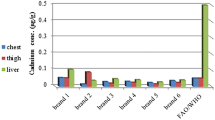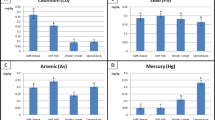Abstract
In Bangladesh, the poultry products are now severely contaminated with toxic heavy metals from different means including natural and man-made pollutions. Interestingly, poultry-based fast foods, which have a quicker preparation time, low price, good taste and easy availability, are very famous among people of all ages. Therefore, burger, sandwich, samosa, shingara, sauce, and noodles were analyzed for the detection of Lead (Pb), Chromium (Cr), Cadmium (Cd), Arsenic (As) and Nickel (Ni) by graphite furnace atomic absorption spectrometry. It has been found that chicken burger contains the highest concentration of Pb (1.14 mg/kg fresh weight), Ni (0.31 mg/kg fw), and As (0.28 mg/kg fw). On the other hand, the highest concentration of Cr (0.101 mg/kg fw) and Cd (0.04 mg/kg fw) was found in the sauce. Unfortunately, all the examined foods contained the heavy metals to an extent that crosses the safety level for human consumption set by different international public health agencies like WHO. Moreover, evaluation of poultry feeds showed high amounts of Pb (range 1.40–6.59 mg/kg fw), which exceeds the safety level set by WHO (0.5 mg/kg). When Pb containing poultry feed was supplied to the chicks and sacrificed after 6 months, Pb was found in all the tissues examined that cross the safety limit. Afterwards, burgers were made from these chickens and high amount of Pb was observed in those burgers too. All these results showed that heavy metals from different sources could make access to the human food chain and impose an immense health risk.


Similar content being viewed by others
References
Wang S, Shi X (2001) Molecular mechanisms of metal toxicity and carcinogenesis. Mol Cell Biochem 222(1):3–9. https://doi.org/10.1023/A:1017918013293
FSANZ (2003) Food standards Australia, New Zealand, Canberra, Australia. The 20th Australian total diet survey: a total diet survey of pesticide residues and contaminants. http://www.foodstandards.gov.au/publications/pages/20thaustraliantotaldietsurveyjanuary2003/20thaustraliantotaldietsurveyfullreport/Default.aspx. Accessed 12 July 2016
Tchounwou PB, Patlolla AK, Centeno JA (2003) Carcinogenic and systemic health effects associated with Arsenic exposure-a critical review. Toxicol Pathol 31(6):575–588. https://doi.org/10.1080/01926230390242007
Cui Y, Zhu Y, Zhai R, Huang Y, Qiu Y, Liang J (2005) Exposure to metal mixtures and human health impacts in a contaminated area in Nanning, China. Environ Int 31(6):784–790. https://doi.org/10.1016/j.envint.2005.05.025
Ahmad JU, Goni MA (2010) Heavy metal contamination in water, soil, and vegetables of the industrial areas in Dhaka, Bangladesh. Environ Assess 166:347–357. https://doi.org/10.1007/s10661-009-1006-6
Islam MS, Ahmed MK, Al-mamun MH (2014) Determination of heavy metals in fish and vegetables in Bangladesh and health implications. Hum Ecol Risk Assess Int J 21:986–1006. https://doi.org/10.1080/10807039.2014.950172
HIES (household income and expenditure survey). Preliminary report on household income and expenditure survey (2011) Bangladesh Bureau of Statistics, Statistics division, Ministry of planning, Dhaka, Bangladesh. http://documents.worldbank.org/curated/en/554771468207262934/pdf/709500WP00PUBL0AndExpenditureSurvey.pdf. Accessed 27 July 2016
Hadiani MR, Farhangi R, Soleimani H, Rastegar H, Cheraghali AM (2014) Evaluation of heavy metals contamination in Iranian foodstuffs: canned tomato paste and tomato Sauce (ketchup). Food Addit Contam B Surveill 7(1):74–78. https://doi.org/10.1080/19393210.2013.848384
JECFA (2003) Summary and conclusions of the 61st meeting of the joint FAO/WHO expert committee on food additives, Rome. http://apps.who.int/iris/bitstream/10665/42849/1/WHO_TRS_922.pdf. Accessed 01 Aug 2016
USEPA (1989) United States Environmental Protection Agency. Guidance manual for assessing human health risks from chemically contaminated, fish and shellfish. Environmental Protection Agency, Washington, DC.7U.S. EPA-503/8-89-002. https://nepis.epa.gov/Exe/ZyPURL.cgi?Dockey=2000DGLF.txt. Accessed 02 July 2016
WHO (1985) Guidelines for the study of dietary intakes of chemical contaminants. World Health Organization, Geneva, pp 1–100, Off set Publication No. 87. http://apps.who.int/iris/bitstream/10665/39255/1/WHO_OFFSET_87.pdf. Accessed 18 July 2016
McLaughlin MJ, Parker DR, Clarke JM (1999) Metals and micronutrients food safety issues. Field Crops Res 60(1–2):143–163. https://doi.org/10.1016/S0378-4290(98)00137-3
Amin NU, Hussain A, Alamzeb S, Begum S (2013) Accumulation of heavy metals in edible parts of vegetables irrigated with waste water and their daily intake to adults and children, District Mardan, Pakistan. Food Chem 136(3–4):1515–1523. https://doi.org/10.1016/j.foodchem.2012.09.058
Acknowledgements
The authors are grateful to the Department of Biochemistry and Molecular Biology, University of Dhaka; Bangladesh Council of Scientific and Industrial Research, and University Grants Commission, Bangladesh for their instrumental and chemical support throughout the study.
Author information
Authors and Affiliations
Corresponding author
Ethics declarations
Conflict of interest
The authors declare that they have no conflict of interest to publish this manuscript.
Additional information
Significance statement
Heavy metals from different industrial sources can contaminate the common ingredient of fast foods, like chicken flesh or liver. Ultimately, these heavy metals may transfer to human and can cause toxicity in the long run.
Rights and permissions
About this article
Cite this article
Nazmul Haque, M., Towhidul Islam, M.M., Tariqul Hassan, M. et al. Determination of Heavy Metal Contents in Frequently Consumed Fast Foods of Bangladesh. Proc. Natl. Acad. Sci., India, Sect. B Biol. Sci. 89, 543–549 (2019). https://doi.org/10.1007/s40011-018-0968-y
Received:
Revised:
Accepted:
Published:
Issue Date:
DOI: https://doi.org/10.1007/s40011-018-0968-y




